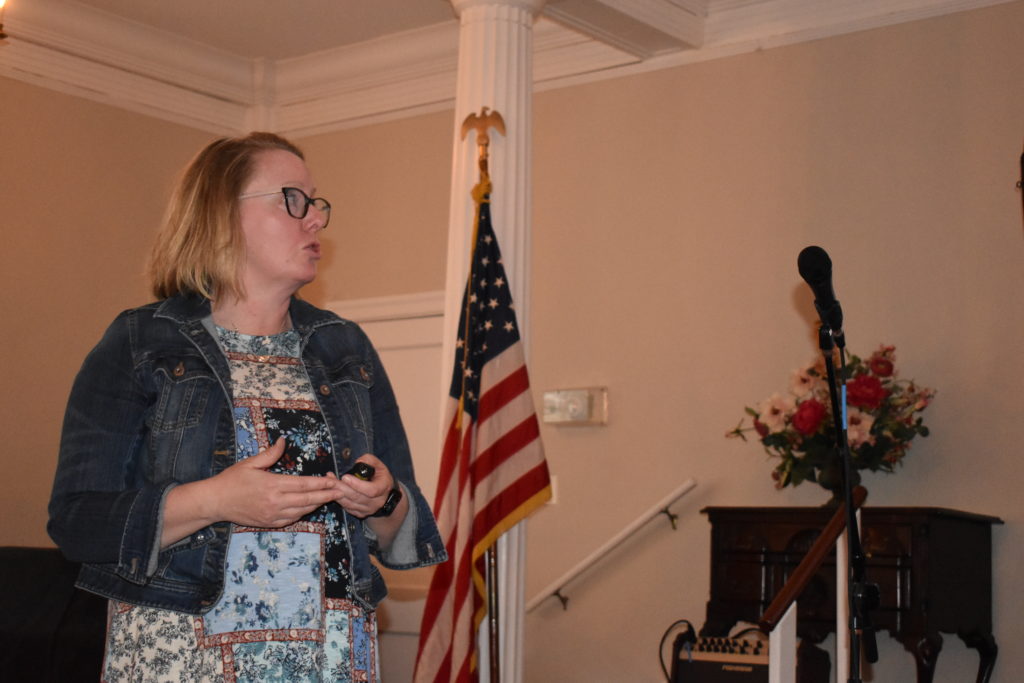
Red Bank Battlefield Director Jen Janofsky changes the slide during her presentation about the remains of Hessian soldiers found at a mass burial site in the trench around Fort Mercer.
On the morning of October 22, 1777, some 2,000 Hessian troops marched 10 miles from Haddonfield to Fort Mercer, along the Delaware River in current day National Park.
The German mercenaries hired by the English government hoped to overrun the fort and enable ships to get up the river and resupply the Philadelphia-based British Army. The 400 soldiers defending the fort were the war-hardened troops of the Rhode Island First and Second regiments, and they got a big break when patriot Jonas Cattell ran from Haddonfield through the backwoods ahead of the Hessian troops to raise the alarm: “The Hessians are Coming.”
Col. Christopher Greene, a distant cousin of Revolutionary War hero General Nathanael Greene, quickly ordered the patriots – many of them African and Native Americans – to turn the cannons pointing at the river around and face the oncoming attack from land.
By the end of the day, 82 Hessian soldiers lay dead in the trench surrounding the fort after an unsuccessful attempt to scale the walls. Another 228 were wounded in the Battle of Red Bank, and 60 were captured. The heavily outnumbered Continental Army troops reported 14 killed and 23 wounded.
Nearly 245 years later during an archeological dig at the battlefield on June 26, 2022, the remains of 15 Hessian soldiers were found.
“They were unceremoniously dumped in a mass grave,” said Red Bank Battlefield Director Jen Jenofsky, also a professor of public history at Rowan University in Glassboro. “Our goals are to treat the remains with dignity and respect, and identifying specific soldiers and assigning them names.”
She and archaeologist Wade P. Catts of Rowan were the leaders of the public participation dig in 2022, and over four days, some 100 volunteers worked screens and processed artifacts from the quarter-acre trench area deeded to the battlefield in 2021 by the family who owned the ground.
“June 26 was the last day of the dig. About 2 p.m. volunteer Wayne Wilson told me ‘I think I found a bone.’ We soon found several femur bones,” noted Janofsky, who along with Catts presented “Archaeology of Hessian Burials at Red Bank” on April 22 at the Haddon Fortnightly.
It was the first of the three-part lecture series called “The Hessian Legacy and the American Revolutionary Revolution,” organized by the Friends of the Indian King Tavern Museum and Rowan’s history department.
The series is anong various Revolutionary-era events leading up to the annual Haddonfield Skirmish on Saturday, June 1. On May 15, a performer will play Thomas Jefferson and discuss his insights on working with friends and foes alike to protect democracy.
“This was an exciting project to be involved with,” said Catts, a registered professional archeologist with more than 40 years of experience as a historical researcher. “The dig had already been rewarding. I found a gold coin 4-and-a-half feet under the ground. We were hoping to learn about the construction of this fort.”
Jenofsky and Catts both were aware of the adage, “You always find something on the last day of the dig,” and sure enough the leg bones were discovered. Further excavations revealed the remains of 15 Hessian soldiers in total that were sent to the New Jersey State Police Forensic Unit for study to help researchers identify their origin.
Contact has also been made with German historians to determine what soldiers were involved in the battle and possibly get in touch with their descendants.
Jenofsky and Catts have published the report “Naked and Torn by the Grapeshot: Fort Mercer and the History, Archaeology and Public Perceptions of a Mass Burial Site at Red Bank Battlefield,” and now are part of a seven-person team of professionals doing further research about the Hessian soldiers who perished on New Jersey soil in 1777.
“Please do not take any screen shots of the remains during the presentation,” Janofsky asked of the crowd of nearly 90 people who filled the Fortnightly auditorium, adding that the remains were of soldiers who should be treated with respect and buried with honor.
There will be more digs at the Red Bank Battlefield this spring and summer, and the public is welcome to participate. The digs will be joined by professional researchers and Rowan University students.
“We are about to start archaeology season,” Janofsky said excitedly. “It is fun to hold an object that has not seen the light of day in 250 years.”


